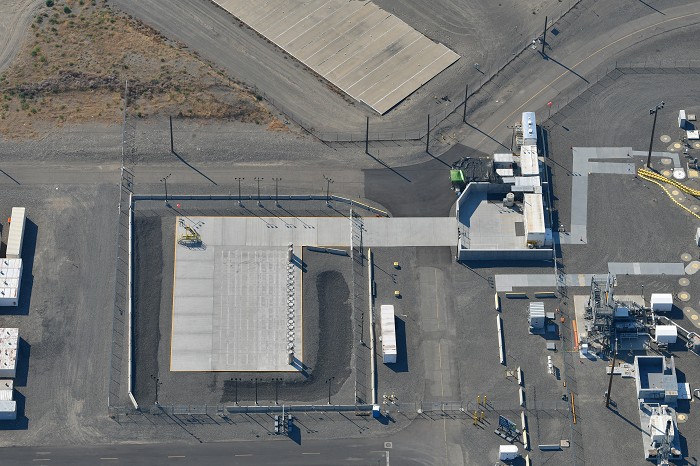 Ion exchange columns filled with cesium sit on a storage pad near the Tank-Side Cesium Removal (TSCR) System at the Hanford Site. Legacy radiological and chemical waste is pumped through TSCR and into an underground waste-storage tank before being tested to ensure it meets the acceptance criteria for immobilization in glass, called vitrification, at the Waste Treatment and Immobilization Plant.
EM Awards $27 Million to Six National Labs to Help Expedite Hanford Tank Waste Cleanup
WASHINGTON, D.C. — The U.S. Department of Energy Office of Environmental Management (EM) awarded $27.3 million for research and development to accelerate the Hanford Site’s tank waste cleanup mission. The funds go to 13 projects led by six national laboratories.
The investment is part of EM’s broader commitment to advancing the tank waste mission at Hanford, according to EM Senior Advisor William “Ike” White.
“By leveraging the expertise of our national labs, EM is continuously looking at opportunities to get waste safely out of tanks, treated and disposed of sooner, driving down risks to workers, the public and the environment,” he said.
Based on a solicitation issued in June, projects were selected that are aimed at developing breakthrough technologies to drastically reduce the life-cycle cost and schedule of the Hanford tank waste cleanup mission.
“Investments like this compliment ongoing progress at Hanford where we have treated over 800,000 gallons of tank waste and are preparing to immobilize it via the Direct-Feed Low-Activity Waste system,” Hanford Site Manager Brian Vance said. “With a challenging, decades-long mission ahead, it’s important to have the most advanced technologies and approaches to help inform our work to accelerate the tank waste mission.”
The investment in the selected projects is based on priorities recommended in the Hanford Tank Waste R&D Roadmap developed by the Network of National Laboratories for Environmental Management and Stewardship.
EM incorporated input from the EM Advisory Board in the implementation of the roadmap. The selected focus and priority areas are also consistent with recommendations by the U.S. Government Accountability Office, National Academies of Sciences, Engineering, and Medicine, and other stakeholders. The selected projects address challenges in waste retrieval, transport and closure; waste pretreatment; waste immobilization and disposal; and mission enabling.
 |
|
“By leveraging the expertise of our national labs, EM is continuously looking at opportunities to get waste safely out of tanks, treated and disposed of sooner, driving down risks to workers, the public and the environment.”
-EM Senior Advisor William "Ike" White
|
Project duration ranges from two to three years. First-year funding for the projects range from $1.3 million to $3 million per project, totaling $27.3 million. Following are the laboratories that received funding and their selected projects:
-
Savannah River National Laboratory
- Integrity Monitoring and Assessment, Prediction, Repair, and Corrosion Control of the Hanford Storage Tanks
- Efficient Electrochemical Denitration and Caustic Generation System for Direct-Feed Waste Pretreatment to Accelerate the Hanford Mission and Operations
- Direct Stabilization of Low-Activity Waste with Advanced Engineered Cellular Magmatics
- Technoeconomic Optimization of Hanford Tank Waste: A Data Driven Approach to Inventory, Logistics and Disposition
-
Pacific Northwest National Laboratory
- Enabling High-Level Waste Sludge Delivery Through In-tank Processing in the Southeast Quadrant of the Hanford Tank Farms
- Expand High-Level Waste Glass Processing Envelope
- Developing a Hanford Grout Modeling Framework and Property Database for Performance Assessments
- Real-time Liquid/Slurry Waste Sampling & Analysis: With User Interface for Comprehensive Data and Uncertainty Analysis
-
Argonne National Laboratory
- The Surface Chemistry of Plutonium Oxide for Waste Pretreatment
-
Idaho National Laboratory
- Digitally Optimized Autonomous Guided Vehicles for Hanford Waste Tank Handling
-
Los Alamos National Laboratory
- Dry Retrieval of Tank Waste
- Real-Time In-Line Monitoring for Hanford Tank Waste Treatment
-
Sandia National Laboratories
- Improved Fundamental Understanding of Aluminum Chemistry and Interactions of Aluminate Anion with Co-Anions: Applications to In-tank and At-tank Pretreatment of Hanford Tank High-Level Waste Sludge
|